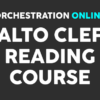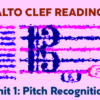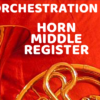A life’s work in codifying the principles of orchestral texture. In some ways, it’s a very narrow view into one specific element of orchestration, and it also is a somewhat personal set of guidelines for Brant’s own profound compositions. And yet it’s a good sourcebook for composers playing with ideas, and wanting to understand timbral relationships. Highly recommended, after you’ve done quite a bit of other foundational reading.
Related Posts
ALTO CLEF READING COURSE ORIENTATION
Welcome to the Orchestration Online Alto Clef Reading Course, designed to quickly and permanently im
ALTO CLEF READING, UNIT 1: PITCH RECOGNITION
FINDING A USEFUL SYSTEM When I was just about 14, I switched over from the violin to viola in my jun
ALTO CLEF READING, UNIT 2: SCORING
Note: make sure to read my first tip in this course on Alto Clef concerning Pitch Recognition, downl
ALTO CLEF READING UNIT 3A: VIOLA
If you’re new to reading the alto clef, but you’ve taken the time to drill yourself on Pitch Recogni
ALTO CLEF READING UNIT 3B: ALTO TROMBONE
If this is your first look at my Alto Clef Reading Course, jump back to the my first two sections on
ALTO CLEF READING UNIT 3C: CONTRALTO VOICE
This represents the final post in my series, “Alto Clef Reading Tips and Drills.” Make sure that you
ALTO CLEF READING, UNIT 4A: 100 SIGHT-SINGING DRILLS
100 ALTO CLEF SIGHT-SINGING DRILLS By this point in my Alto Clef Reading Course, you should have sha
Orchestration Tip: Horn Middle Register
For better control in delicate scoring, use the horn’s middle register, especially in the octave bet








